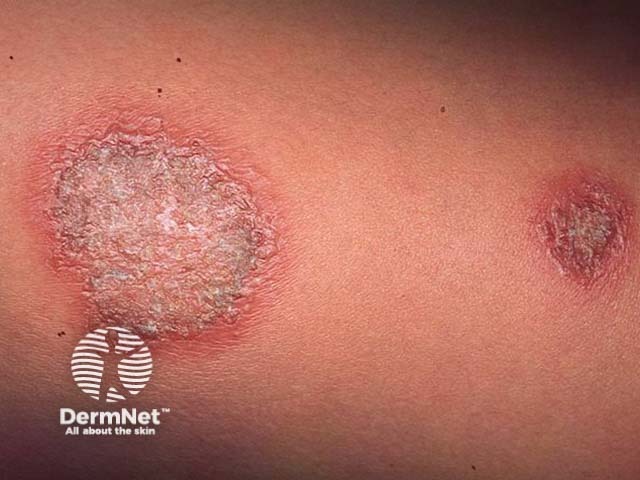Main menu
Common skin conditions

NEWS
Join DermNet PRO
Read more
Quick links
For each of the ten cases, study the image(s) and then answer the questions. You can click on the image to view a larger version if required.
Each case should take approximately five minutes to complete. There is a list of suggested further reading material at the end of the quiz.
When you finish the quiz, you can download a certificate.

What is the diagnosis?
This is nummular dermatitis (also known as discoid eczema), an idiopathic skin disorder.
Individual lesions start as pruritic papules or vesicles that become confluent plaques. They may arise on any area of skin, most frequently the lower legs and dorsa of the hands. Characteristically there are coin-shaped erythematous lesions, which may be exudative and crusted or dry and scaly. Frequently, staphylococcus aureus can be cultured; there is debate whether this is a secondary infection or whether it has a primary role in pathogenesis. Nummular dermatitis is frequently confused with other forms of dermatitis, psoriasis, tinea corporis and pityriasis rosea.
Suggest management.
Nummular dermatitis can be hard to control but generally improves or remits after several months.
Minimise heat and humidity; the patient should wear cool clothing
Emollients should be applied frequently and liberally, especially after bathing
Potent topical steroids are applied to the plaques once or twice daily for two to four weeks, followed by mild topical steroids. A cream base is most suitable for weeping lesions; an ointment base is more appropriate if the lesions are dry.
Oral antistaphylococcal antibiotics are recommended during the exudative phase, and are sometimes helpful long term (eg dicloxacillin, erythromycin)
Phototherapy or photochemotherapy (PUVA) is helpful for extensive dermatitis
Rarely, systemic steroids and/or other immunosuppressive agents are necessary for severe cases.